The Global Renewable Energy and Sectoral Electrification (GREaSE) Model for Rapid Energy Transition Scenarios
Abstract
1. Introduction
1.1. Background
1.2. Energy Transition Scenarios
- Fossil fuels remain in the energy mix while renewables are scaled up, but declining fossil fuel availability or policy-driven restrictions on their use can create supply constraints.
- Energy must be diverted from meeting the demand to facilitating the transition itself—building renewable infrastructure requires material extraction, manufacturing, and construction, all of which consume energy.
- Scarcity and energy prices influence investment decisions, affecting both the speed and scale of renewable deployment.
- Climate policy settings shape incentives for investment, demand-side reduction, and fossil fuel phase-out, but the effectiveness of policy depends on how it interacts with these system-level feedbacks.
- Road and rail transport are relatively straightforward to electrify but require infrastructure upgrades and supply chain adaptations [9].
- Aviation and shipping face significant hurdles, as current battery technologies lack the energy density needed for long-haul applications, making biofuels or synthetic fuels likely alternatives [10].
- Industrial heat processes, particularly in sectors such as steel and cement production, often require extremely high temperatures that are difficult to achieve through direct electrification alone [11].
1.3. Energy System Models
1.4. Summary
- Existing and future fossil fuel supply, renewable energy deployment, and energy demand;
- Electrification of sectoral energy demand;
- The diversion of energy into building new renewable energy infrastructure, and the implications for net energy availability;
- Supply responses to scarcity and the impact of climate policy settings on the speed and composition of the transition.
2. Materials and Methods
2.1. Conceptual Model
- Population;
- Per capita activity;
- Electrification of demand;
- Climate policy setting.
2.2. Mathematical Model
2.2.1. Demand
2.2.2. Scarcity and Supply Feedbacks
2.2.3. Fossil Fuel Depletion and Renewable Energy Saturation
2.2.4. Dynamic Growth Rates
2.2.5. Nuclear-Fuelled Electricity
2.2.6. Method Summary
3. Scenario Parameters
3.1. Static Parameters
| Demand Sector, i | Share of Per Capita Activity, APC,i/APC (%) | Initial Proportion Electric, Li (t = 0) | Efficiency Gain from Electrification, Effi |
|---|---|---|---|
| Industry | 33.7% | 29% | 20% |
| Transport | 30.8% | 1% | 50% |
| Residential | 22.5% | 28% | 20% |
| Commercial and Public Services | 8.8% | 53% | 20% |
| Agriculture/ Forestry | 2.4% | 31% | 20% |
| Fishing | 0.1% | 11% | 20% |
| Other Non-specified | 1.7% | 62% | 20% |
- Initial production rate (NRj) is taken as ‘total energy supply’ minus the quantities allocated to ‘non-energy use’ within ‘total final consumption’ for each source.
- Fraction to electricity (NRFj) for coal and gas are each taken as ‘total energy supply’ minus ‘total final consumption’ minus ‘non-energy use’, divided by NRj.
- Efficiency of electricity conversion (NREj) is taken as ‘electricity generation’ divided by (NRj.NRFj).
| Model Parameter | Units | Coal | Oil | Gas | Nuclear |
|---|---|---|---|---|---|
| Initial fraction diverted to electricity, NRFj (t = 0) | % | 82% | 7% | 61% | 100% |
| Efficiency of electricity conversion, NREj | % | 23% | 23% | 24% | 100% |
| Initial production rate, NRj (t = 0) | EJ/yr | 175 | 159 | 138 | 9.7 |
| Remaining resource, RRj | EJ | 25,208 | 9320 | 6974 | 1260 |
| Initial growth rate of fossil fuels and nuclear, rj (t = 0) | % p.a. | 3% | 3% | 3% | 0% |
| Carbon intensity of fossil fuels, Cj | MtCO2/EJ | 96.3 | 73.3 | 56.1 | - |
- Dupont et al. [33] estimates global solar potential to be between 165 and 1089 EJ/yr, depending on the EROI (less energy is available at higher EROI).
- For hydro, given the specific impacts and long-lived nature of the infrastructure, there is less rapid growth compared with solar and wind. Moriarty and Honnery [36] provide a review of estimates from the literature in the range of 50 to 95 EJ/yr, with a prevalence of values around 50.
| Model Parameter | Units | Solar | Wind | Hydro |
|---|---|---|---|---|
| Initial renewable electricity supply, REk,net (t = 0) | EJ/yr | 4.7 | 7.6 | 16.1 |
| Saturation potential of renewable electricity, REk,max | EJ/yr | 200 | 700 | 50 |
| Energy return on investment of renewable electricity, EROIk | - | 15 | 20 | 70 |
| Lifespan of renewable electricity, Tk | yrs | 25 | 25 | 75 |
| Model Parameter | Units | Value |
|---|---|---|
| Initial biofuel supply, RERF,net (t = 0) | EJ/yr | 39.3 |
| Saturation potential of biofuel, RERF,max | EJ/yr | 200 |
| Energy return on investment of biofuel, EROIRF | - | 2 |
| Fossil Fuel Emissions, GHGtarget (t) | ||
|---|---|---|
| Year | Annual (GtCO2/yr) | Cumulative Since 2023 (GtCO2) |
| 2025 | 28.8 | 96.0 |
| 2030 | 17.3 | 198.6 |
| 2035 | 12.5 | 270.6 |
| 2040 | 7.7 | 318.6 |
| 2045 | 2.9 | 342.6 |
| 2050 | 0.0 | 345.4 |
| 2100 | 0.0 | 345.4 |
3.2. Exogenous Scenario Variables
4. Results and Discussion
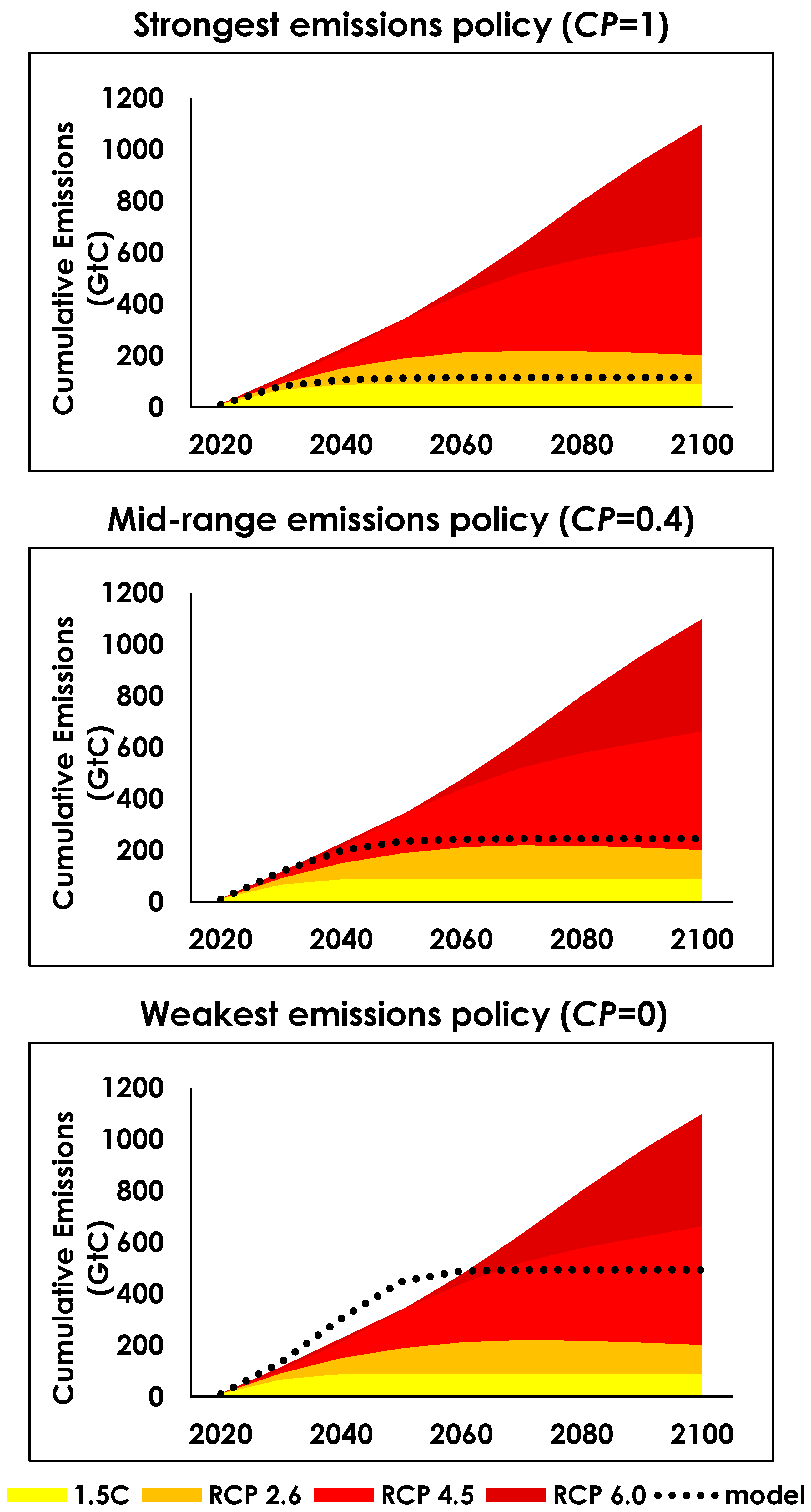

- Global aggregation of supply and demand, without consideration of trade within or between countries/regions;
- Division into just two overarching categories of energy use (fuel and electricity);
- Uniform response to general ‘scarcity’ of fuel or electricity, ignoring the potential for some fuels or electricity sources to have a market advantage over others;
- Uniform response by all fossil fuels to climate policy and emissions overshoot;
- No explicit treatment of the energy that must be invested in electrification (e.g., build-out of new industrial plant, electric vehicles, batteries, etc.);
- Excluding negative emissions technologies such as BECCS;
- Lack of constraints or delays imposed by the need for additional electrical storage and/or distribution infrastructure.
5. Conclusions
- Policymakers updating local climate risk profiles (including adaptive capacity) in light of changes in global climate and/or energy policy;
- Industries and governments building a shared understanding of the role played by sectoral electrification in climate change mitigation;
- Economists exploring the influence and significance of renewable energy saturation potential in meeting future global energy demands, with resultant limits on economic growth;
- Educators guiding non-experts (including students) to raise community-level awareness of the trade-offs and interconnected risks associated with meeting energy demand versus achieving 1.5 °C climate targets.
Author Contributions
Funding
Data Availability Statement
Acknowledgments
Conflicts of Interest
References
- Rogelj, J.; Shindell, D.; Jiang, K.; Fifita, S.; Forster, P.; Ginzburg, V.; Handa, C.; Kheshgi, H.; Kobayashi, S.; Kriegler, E.; et al. Mitigation Pathways Compatible with 1.5 °C in the Context of Sustainable Development. In Global Warming of 1.5 °C. An IPCC Special Report on the Impacts of Global Warming of 1.5 °C Above Pre-Industrial Levels and Related Global Greenhouse Gas Emission Pathways, in the Context of Strengthening the Global Response to the Threat of Climate Change, Sustainable Development, and Efforts to Eradicate Poverty; Masson-Delmotte, V., Zhai, P., Pörtner, H.-O., Roberts, D., Skea, J., Shukla, P.R., Pirani, A., Moufouma-Okia, W., Péan, C., Pidcock, R., et al., Eds.; Cambridge University Press: Cambridge, UK; New York, NY, USA, 2022; pp. 93–174. [Google Scholar] [CrossRef]
- Ram, M.; Bogdanov, D.; Aghahosseini, A.; Oyewo, A.S.; Gulagi, A.; Child, M.; Caldera, U.; Sadovskaia, K.; Farfan, J.; Breyer, C. The role of renewable energy in the global energy transformation. Energy Strategy Rev. 2019, 24, 38–50. [Google Scholar] [CrossRef]
- Byers, E.; Krey, V.; Kriegler, E.; Riahi, K.; Schaeffer, R.; Kikstra, J.; Lamboll, R.; Nicholls, Z.; Sanstad, M.; Smith, C.; et al. AR6 Scenarios Database Hosted by IIASA, International Institute for Applied Systems Analysis, 2022. Available online: https://doi.org/10.5281/zenodo.5886911 (accessed on 25 March 2025).
- Murphy, D.J.; McManus, P. The energy return on investment of BECCS: Is BECCS a threat to energy security? Energy Environ. Sci. 2018, 11, 2909–2924. [Google Scholar] [CrossRef]
- IRENA. World Energy Transitions Outlook 2023: 1.5 °C Pathway. International Renewable Energy Agency, Abu Dhabi. 2023. Available online: https://www.irena.org/publications (accessed on 25 March 2025).
- Murphy, D.J.; Hall, C.A.; Dale, M.; Cleveland, C. Order from chaos: A preliminary protocol for determining the EROI of fuels. Sustainability 2011, 3, 1888–1907. [Google Scholar] [CrossRef]
- Capellán-Pérez, I.; De Castro, C.; González, L.J.M. Dynamic Energy Return on Energy Investment (EROI) and material requirements in scenarios of global transition to renewable energies. Energy Strategy Rev. 2019, 26, 100399. [Google Scholar] [CrossRef]
- Gaur, A.; Balyk, O.; Glynn, J.; Curtis, J.; Daly, H. Low energy demand scenario for feasible deep decarbonisation: Whole energy systems modelling for Ireland. Renew. Sustain. Energy Transit. 2022, 2, 100024. [Google Scholar] [CrossRef]
- Pulido-Sánchez, D.; Capellán-Pérez, I.; De Castro, C.; Frechoso, F. Material and energy requirements of transport electrification. Energy Environ. Sci. 2022, 15, 4872–4910. [Google Scholar] [CrossRef]
- Fragkos, P. Decarbonizing the international shipping and aviation sectors. Energies 2022, 15, 9650. [Google Scholar] [CrossRef]
- Lovegrove, K.; Alexander, D.; Bader, R.; Stephen, E.; Michael, L.; Mojiri, A.; Rutovitz, J.; Hugh, S.; Cameron, S.; Urkalan, K.; et al. Renewable Energy Options for Industrial Process Heat; Australian Renewable Energy Agency (ARENA): Canberra, Australia, 2019. [Google Scholar]
- Fajardy, M.; Reiner, D.M. Electrification of residential and commercial heating. In Handbook on Electricity Markets; Edward Elgar Publishing: Cheltenham, UK, 2021; pp. 506–539. [Google Scholar]
- Stakens, J.; Mutule, A.; Lazdins, R. Agriculture electrification, emerging technologies, trends and barriers: A comprehensive literature review. Latv. J. Phys. Tech. Sci. 2023, 60, 18–32. [Google Scholar] [CrossRef]
- IEA. Global Energy and Climate Model—Documentation; International Energy Agency: Paris, France, 2024. [Google Scholar]
- Shell. World Energy Model: A View to 2100; Shell International BV: The Hague, Netherlands, 2017. [Google Scholar]
- Robertson, S. Transparency, trust, and integrated assessment models: An ethical consideration for the Intergovernmental Panel on Climate Change. Wiley Interdiscip. Rev. Clim. Chang. 2021, 12, e679. [Google Scholar] [CrossRef]
- Pereira, L.; Kuiper, J.J.; Selomane, O.; Aguiar, A.P.D.; Asrar, G.R.; Bennett, E.M.; Biggs, R.; Calvin, K.; Hedden, S.; Hsu, A.; et al. Advancing a toolkit of diverse futures approaches for global environmental assessments. Ecosyst. People 2021, 17, 191–204. [Google Scholar] [CrossRef]
- Savvidis, G.; Siala, K.; Weissbart, C.; Schmidt, L.; Borggrefe, F.; Kumar, S.; Pittel, K.; Madlener, R.; Hufendiek, K. The gap between energy policy challenges and model capabilities. Energy Policy 2019, 125, 503–520. [Google Scholar] [CrossRef]
- Oberle, S.; Elsland, R. Are open access models able to assess today’s energy scenarios? Energy Strategy Rev. 2019, 26, 100396. [Google Scholar] [CrossRef]
- Grahn, M.; Klampfl, E.; Whalen, M.J.; Wallington, T.J.; Lindgren, K. Description of the Global Energy Systems Model GET-RC 6.1; Chalmers University of Technology: Gothenburg, Sweden, 2013. [Google Scholar]
- Bosetti, V.; Carraro, C.; Galeotti, M.; Massetti, E.; Tavoni, M. A world induced technical change hybrid model. Energy J. 2006, 27 (Suppl. S2), 13–37. [Google Scholar] [CrossRef]
- Howells, M.; Rogner, H.; Strachan, N.; Heaps, C.; Huntington, H.; Kypreos, S.; Hughes, A.; Silveira, S.; DeCarolis, J.; Bazillian, M.; et al. OSeMOSYS: The open source energy modeling system: An introduction to its ethos, structure and development. Energy Policy 2011, 39, 5850–5870. [Google Scholar] [CrossRef]
- Blondeel, M.; Price, J.; Bradshaw, M.; Pye, S.; Dodds, P.; Kuzemko, C.; Bridge, G. Global energy scenarios: A geopolitical reality check. Glob. Environ. Chang. 2024, 84, 102781. [Google Scholar] [CrossRef]
- Yokobori, K.; Kaya, Y. Environment, Energy and Economy: Strategies for Sustainability; Bookwell Publications: Delhi, India, 1999. [Google Scholar]
- Hall, C.A.S. EROI and Industrial Economies. In Energy Return on Investment; Lecture Notes in Energy; Springer: Cham, Switzerland, 2017; Volume 36. [Google Scholar] [CrossRef]
- Ward, J.D.; Mohr, S.H.; Myers, B.R.; Nel, W.P. High estimates of supply constrained emissions scenarios for long-term climate risk assessment. Energy Policy 2012, 51, 598–604. [Google Scholar] [CrossRef]
- IEA. World Energy Statistics and Balances; International Energy Agency: Paris, France, 2024; Available online: https://www.iea.org/data-and-statistics/data-product/world-energy-statistics-and-balances (accessed on 25 March 2025).
- Energy Institute. Statistical Review of World Energy. 2024. Available online: https://www.energyinst.org/statistical-review/home (accessed on 25 March 2025).
- GHG Protocol. Emissions Factors, Within Calculation Tools and Guidance. 2024. Available online: https://ghgprotocol.org/calculation-tools-and-guidance (accessed on 25 March 2025).
- NEA. Uranium 2022: Resources, Production and Demand. Joint Report by the Nuclear Energy Agency and International Atomic Energy Agency; OECD Publishing: Paris, France, 2023. [Google Scholar]
- Murphy, D.J.; Raugei, M.; Carbajales-Dale, M.; Rubio Estrada, B. Energy return on investment of major energy carriers: Review and harmonization. Sustainability 2022, 14, 7098. [Google Scholar] [CrossRef]
- Moriarty, P.; Honnery, D. Can renewable energy power the future? Energy Policy 2016, 93, 3–7. [Google Scholar] [CrossRef]
- Dupont, E.; Koppelaar, R.; Jeanmart, H. Global available solar energy under physical and energy return on investment constraints. Appl. Energy 2020, 257, 113968. [Google Scholar] [CrossRef]
- Bosch, J.; Staffell, I.; Hawkes, A.D. Temporally explicit and spatially resolved global offshore wind energy potentials. Energy 2018, 163, 766–781. [Google Scholar] [CrossRef]
- Dupont, E.; Koppelaar, R.; Jeanmart, H. Global available wind energy with physical and energy return on investment constraints. Appl. Energy 2018, 209, 322–338. [Google Scholar] [CrossRef]
- Moriarty, P.; Honnery, D. What is the global potential for renewable energy? Renew. Sustain. Energy Rev. 2012, 16, 244–252. [Google Scholar] [CrossRef]
- Haberl, H.; Beringer, T.; Bhattacharya, S.C.; Erb, K.H.; Hoogwijk, M. The global technical potential of bio-energy in 2050 considering sustainability constraints. Curr. Opin. Environ. Sustain. 2010, 2, 394–403. [Google Scholar] [CrossRef] [PubMed]
- UNEP. Emissions Gap Report 2024; United Nations Environment Programme: Nairobi, Kenya, 2024. [Google Scholar] [CrossRef]
- United Nations. World Population Prospects: 2024 Revision. United Nations Department of Economic and Social Affairs, Population Division. 2024. Available online: https://population.un.org/wpp/ (accessed on 25 March 2025).
- O’Sullivan, J.N. Demographic delusions: World population growth is exceeding most projections and jeopardising scenarios for sustainable futures. World 2023, 4, 545–568. [Google Scholar] [CrossRef]
- Zhang, J.; Roumeliotis, I.; Zolotas, A. Sustainable aviation electrification: A comprehensive review of electric propulsion system architectures, energy management, and control. Sustainability 2022, 14, 5880. [Google Scholar] [CrossRef]
- Qazi, S.; Venugopal, P.; Rietveld, G.; Soeiro, T.B.; Shipurkar, U.; Grasman, A.; Watson, A.J.; Wheeler, P. Powering maritime: Challenges and prospects in ship electrification. IEEE Electrif. Mag. 2023, 11, 74–87. [Google Scholar] [CrossRef]
- United Nations. Sustainable Development Goals: Goal 7—Ensure access to Affordable, Reliable, Sustainable and Modern Energy for All. 2025. Available online: https://sdgs.un.org/goals/goal7 (accessed on 25 March 2025).

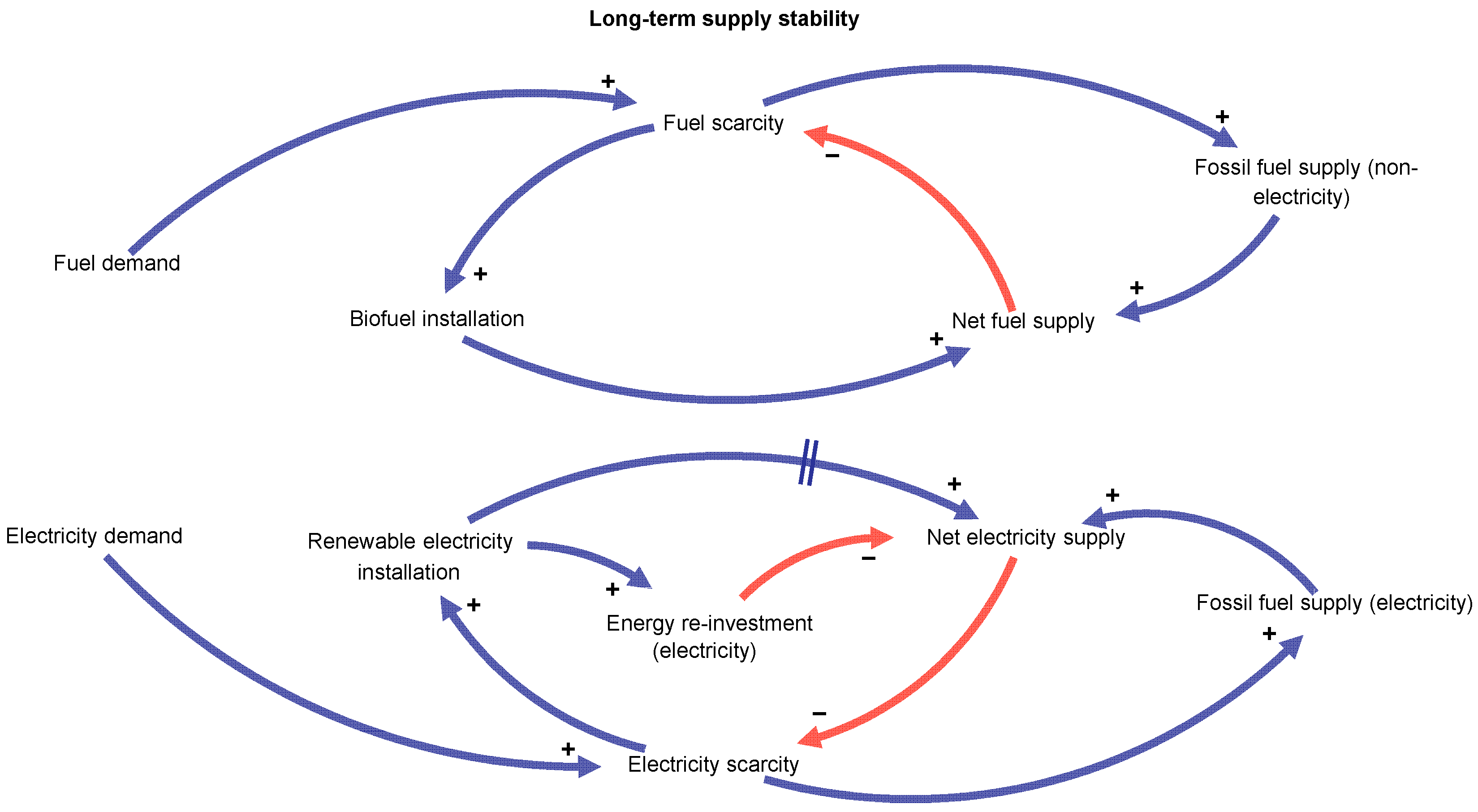
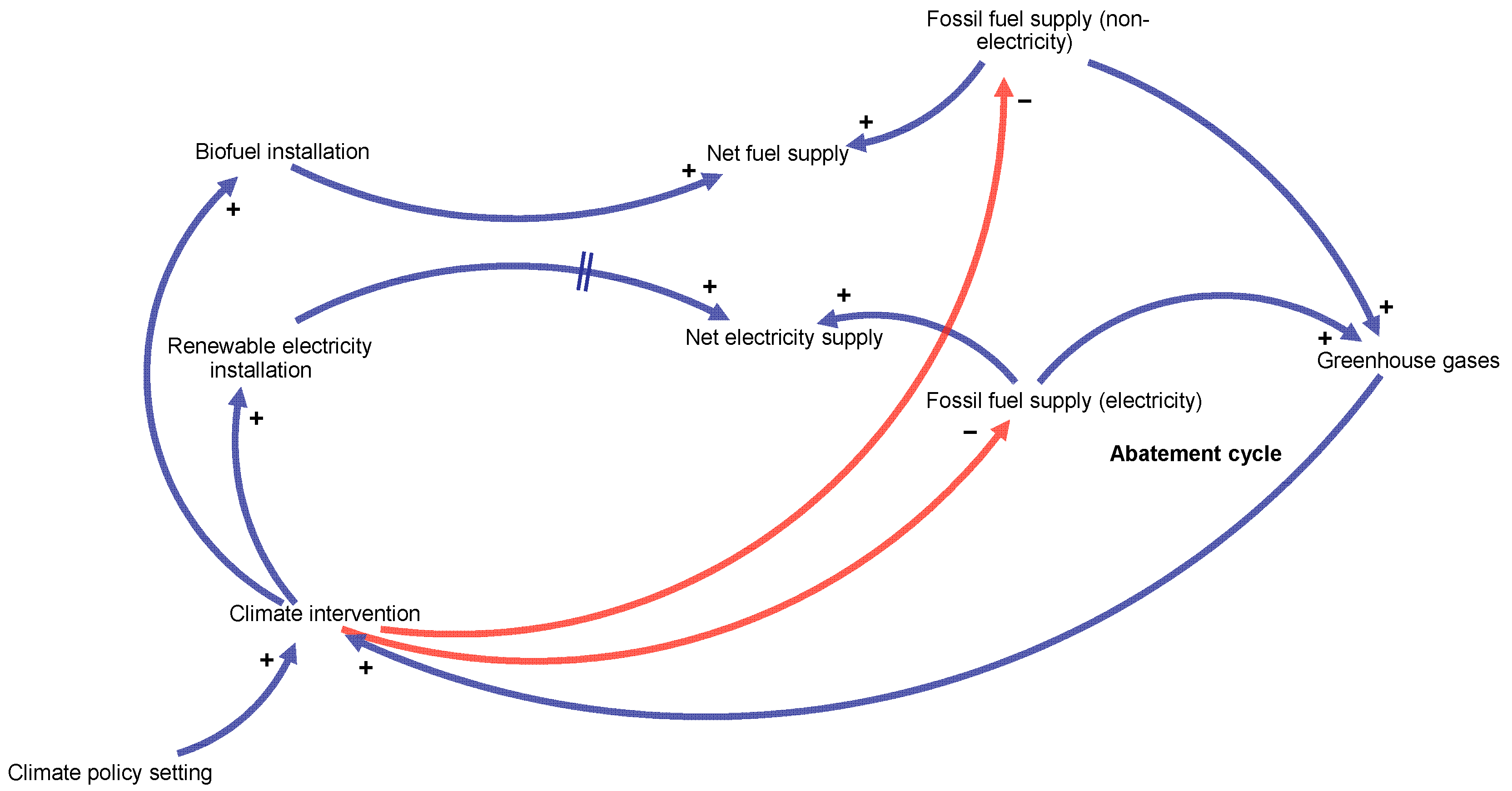





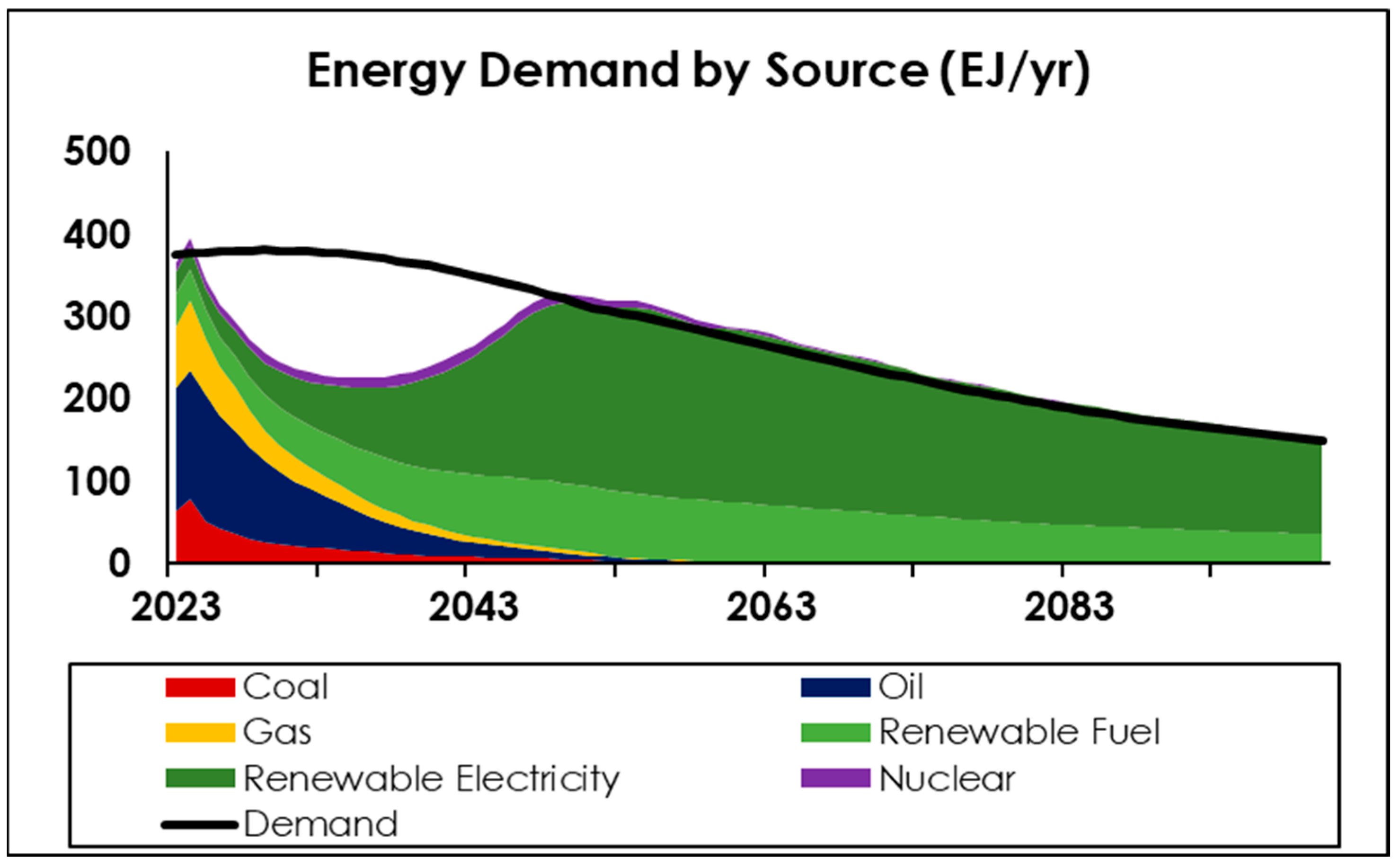
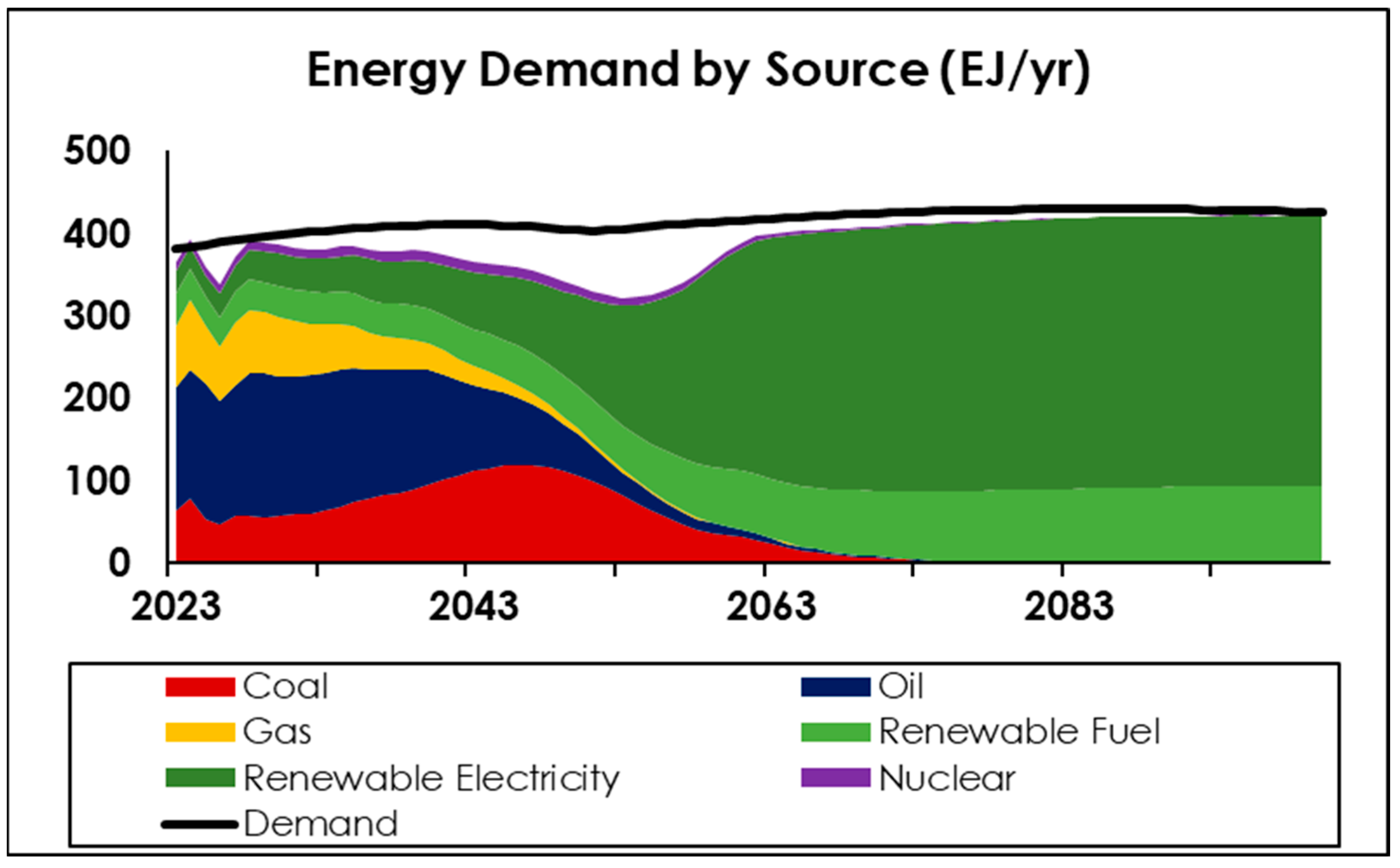
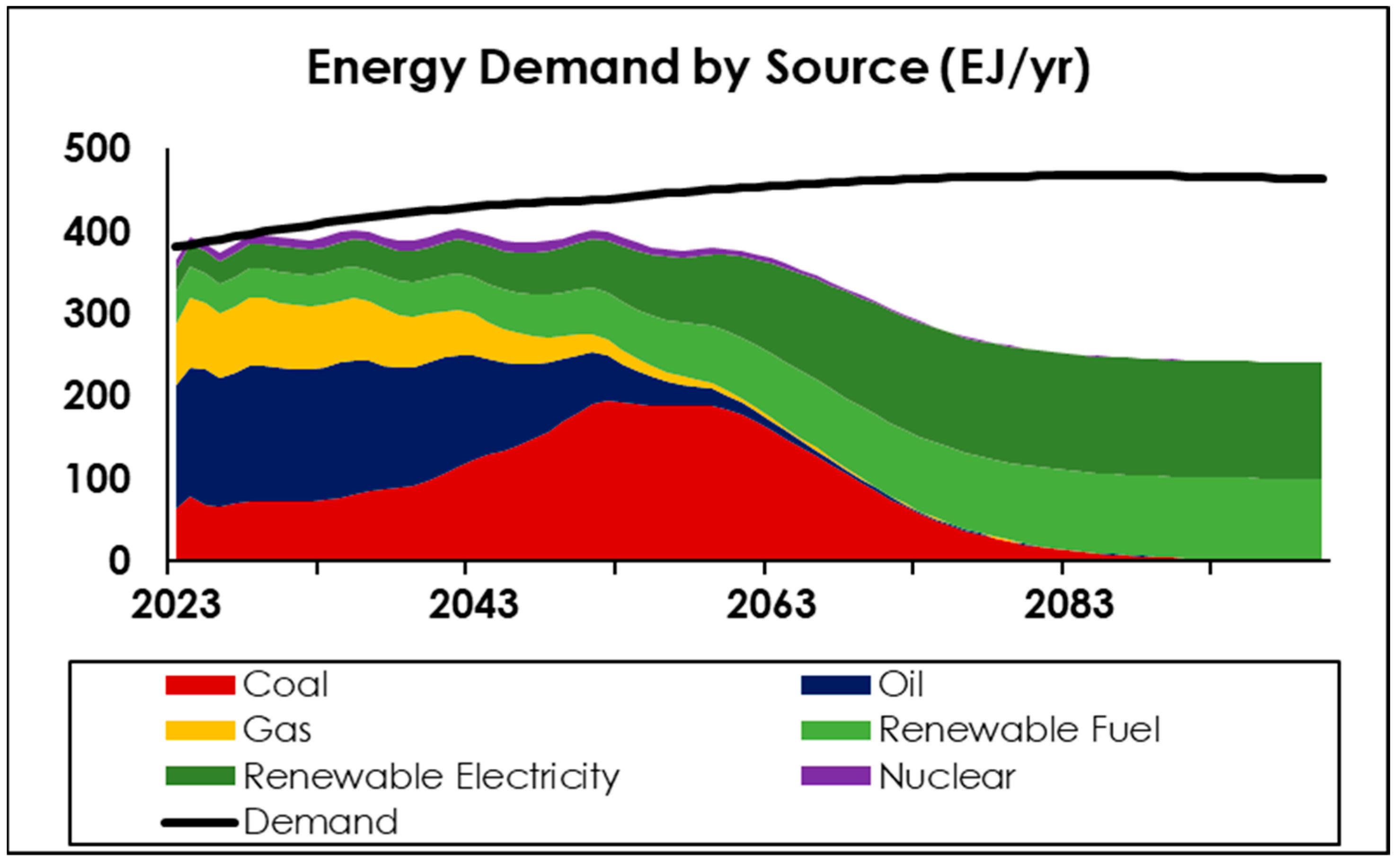

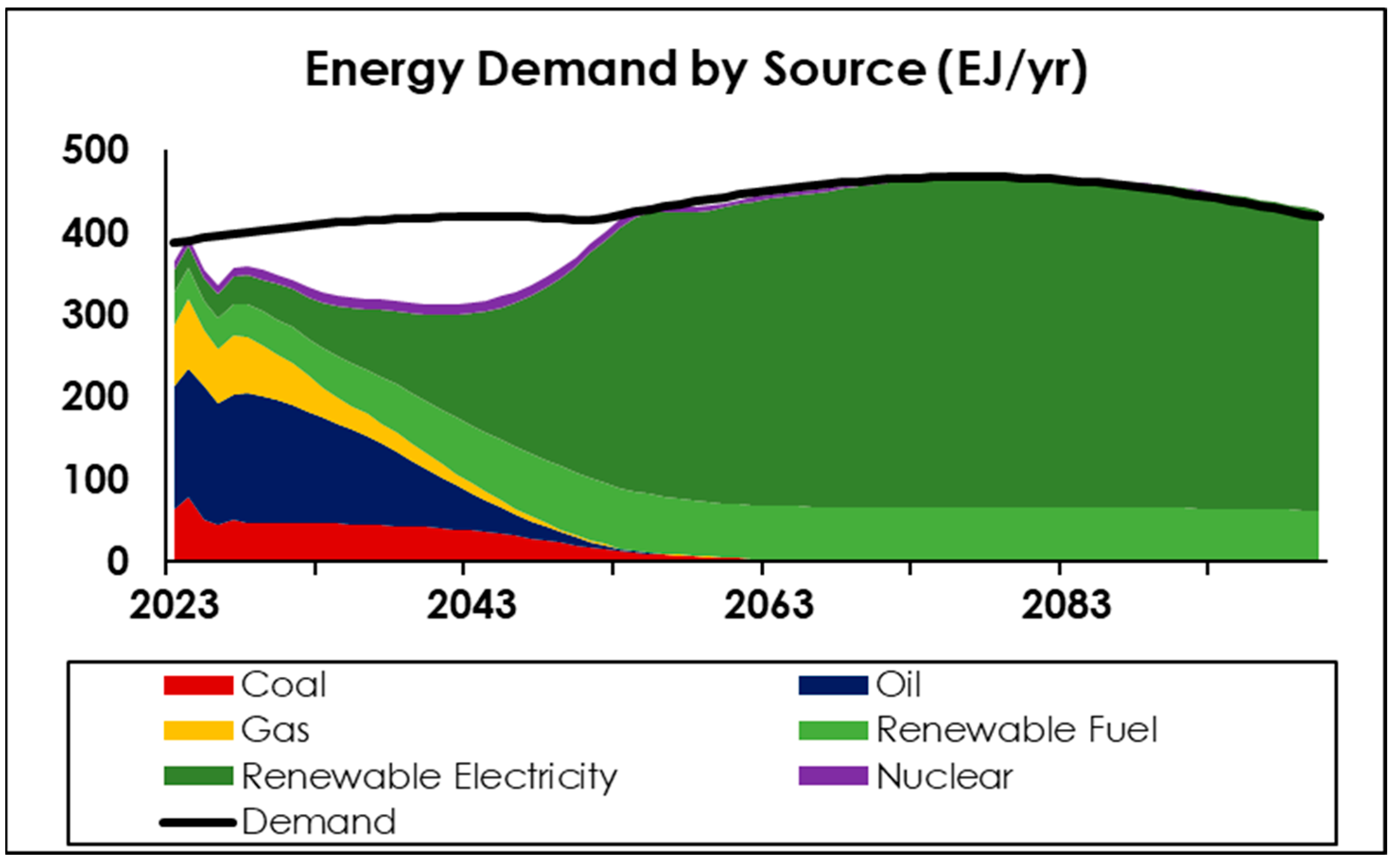
| Scenario | Final Per Capita Activity APC (t = 2100) (GJ/Person/yr) | Similar Present-Day Countries (GJ/Person/yr) |
|---|---|---|
| Degrowth (0.5× current) | 24.4 | Indonesia (23.4) Colombia (24.1) Costa Rica (31.2) |
| Static (current) | 47.7 | Thailand (44.1) Brazil (45.7) Argentina (53.9) |
| Medium growth (1.5× current) | 71.0 | United Kingdom (66.9) Spain (66.9) Italy (76.0) |
| High growth (2× current) | 94.4 | Slovenia (92.9) Germany (94.2) New Zealand (99.4) |
| Demand Sector, i | Current Level of Electrification, Li (t = 0) | Maximum Level of Electrification, Li (t) |
|---|---|---|
| Industry | 29% | up to 100% |
| Transport | 1% | up to 75% |
| Residential | 28% | up to 100% |
| Commercial and Public Services | 53% | up to 100% |
| Agriculture/Forestry | 31% | up to 60% |
| Fishing | 11% | up to 50% |
| Other Non-specified | 62% | up to 75% |
Disclaimer/Publisher’s Note: The statements, opinions and data contained in all publications are solely those of the individual author(s) and contributor(s) and not of MDPI and/or the editor(s). MDPI and/or the editor(s) disclaim responsibility for any injury to people or property resulting from any ideas, methods, instructions or products referred to in the content. |
© 2025 by the authors. Licensee MDPI, Basel, Switzerland. This article is an open access article distributed under the terms and conditions of the Creative Commons Attribution (CC BY) license (https://creativecommons.org/licenses/by/4.0/).
Share and Cite
Hopeward, J.; Davis, R.; O’Connor, S.; Akiki, P. The Global Renewable Energy and Sectoral Electrification (GREaSE) Model for Rapid Energy Transition Scenarios. Energies 2025, 18, 2205. https://doi.org/10.3390/en18092205
Hopeward J, Davis R, O’Connor S, Akiki P. The Global Renewable Energy and Sectoral Electrification (GREaSE) Model for Rapid Energy Transition Scenarios. Energies. 2025; 18(9):2205. https://doi.org/10.3390/en18092205
Chicago/Turabian StyleHopeward, James, Richard Davis, Shannon O’Connor, and Peter Akiki. 2025. "The Global Renewable Energy and Sectoral Electrification (GREaSE) Model for Rapid Energy Transition Scenarios" Energies 18, no. 9: 2205. https://doi.org/10.3390/en18092205
APA StyleHopeward, J., Davis, R., O’Connor, S., & Akiki, P. (2025). The Global Renewable Energy and Sectoral Electrification (GREaSE) Model for Rapid Energy Transition Scenarios. Energies, 18(9), 2205. https://doi.org/10.3390/en18092205







